STRM059: Multi-Cuisine Restaurant Business Research Project Delhi
VerifiedAdded on 2023/06/14
|84
|15330
|227
Project
AI Summary
This business research project, STRM059, investigates the viability of opening a multi-cuisine restaurant in Delhi, India. It includes an introduction outlining the project's aims and objectives, such as understanding business viability, analyzing customer influx, understanding competitor forces, and understanding macroeconomic factors. The project scope encompasses a macro-environmental analysis, industry competitive factor analysis, market segmentation, and customer analysis. The literature review covers background information on India, external market analysis using SLEPT analysis, internal market analysis using Porter’s Five Forces, market segmentation, and customer analysis. The process section details the research philosophy, approach, design, method, sampling techniques, data collection methods, data analysis methods, ethical considerations, and limitations. The discussion and evaluation section assesses the normality, validity, and reliability of the collected data. Finally, the conclusion and recommendations section summarizes the findings and suggests strategies for establishing a successful restaurant in Delhi.
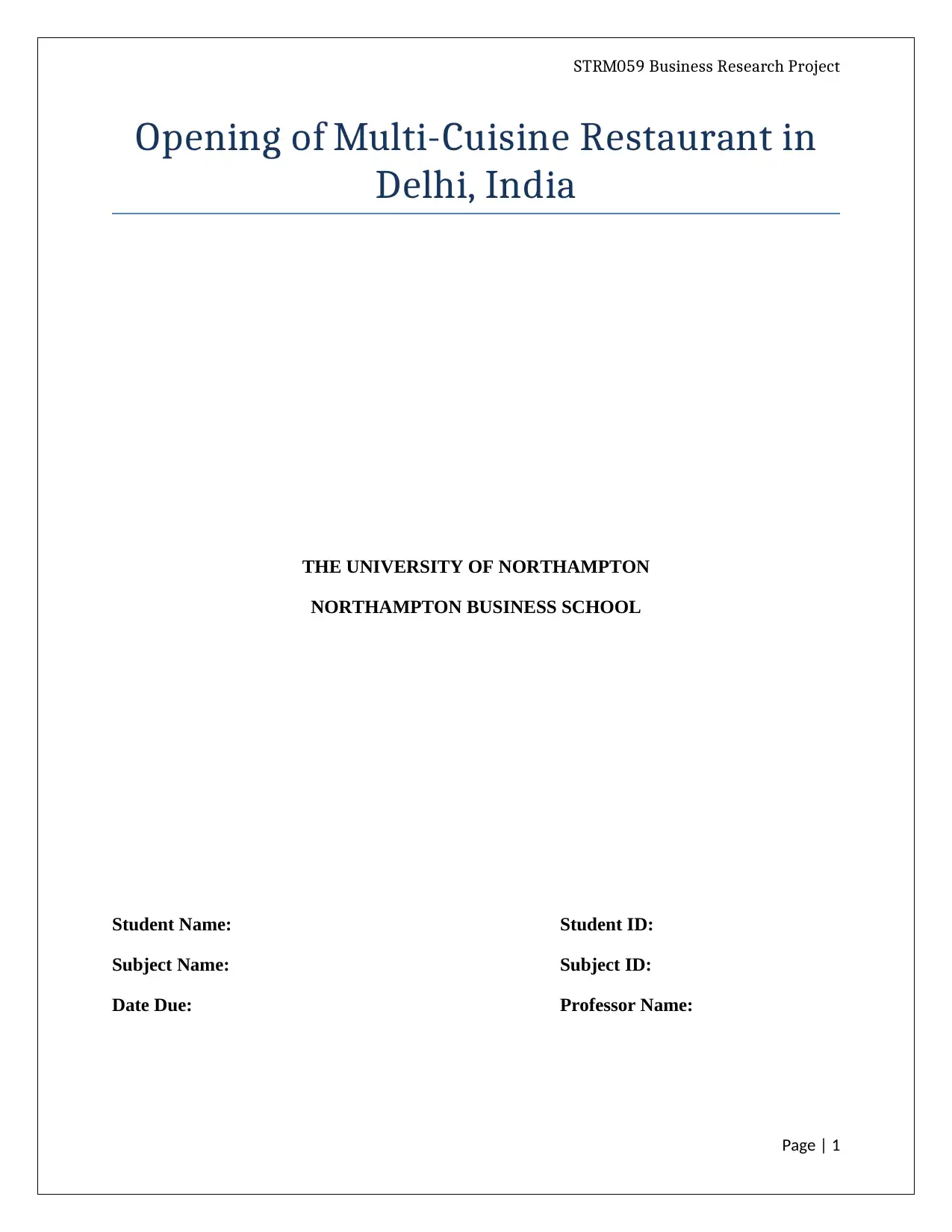
STRM059 Business Research Project
Opening of Multi-Cuisine Restaurant in
Delhi, India
THE UNIVERSITY OF NORTHAMPTON
NORTHAMPTON BUSINESS SCHOOL
Student Name: Student ID:
Subject Name: Subject ID:
Date Due: Professor Name:
Page | 1
Opening of Multi-Cuisine Restaurant in
Delhi, India
THE UNIVERSITY OF NORTHAMPTON
NORTHAMPTON BUSINESS SCHOOL
Student Name: Student ID:
Subject Name: Subject ID:
Date Due: Professor Name:
Page | 1
Paraphrase This Document
Need a fresh take? Get an instant paraphrase of this document with our AI Paraphraser
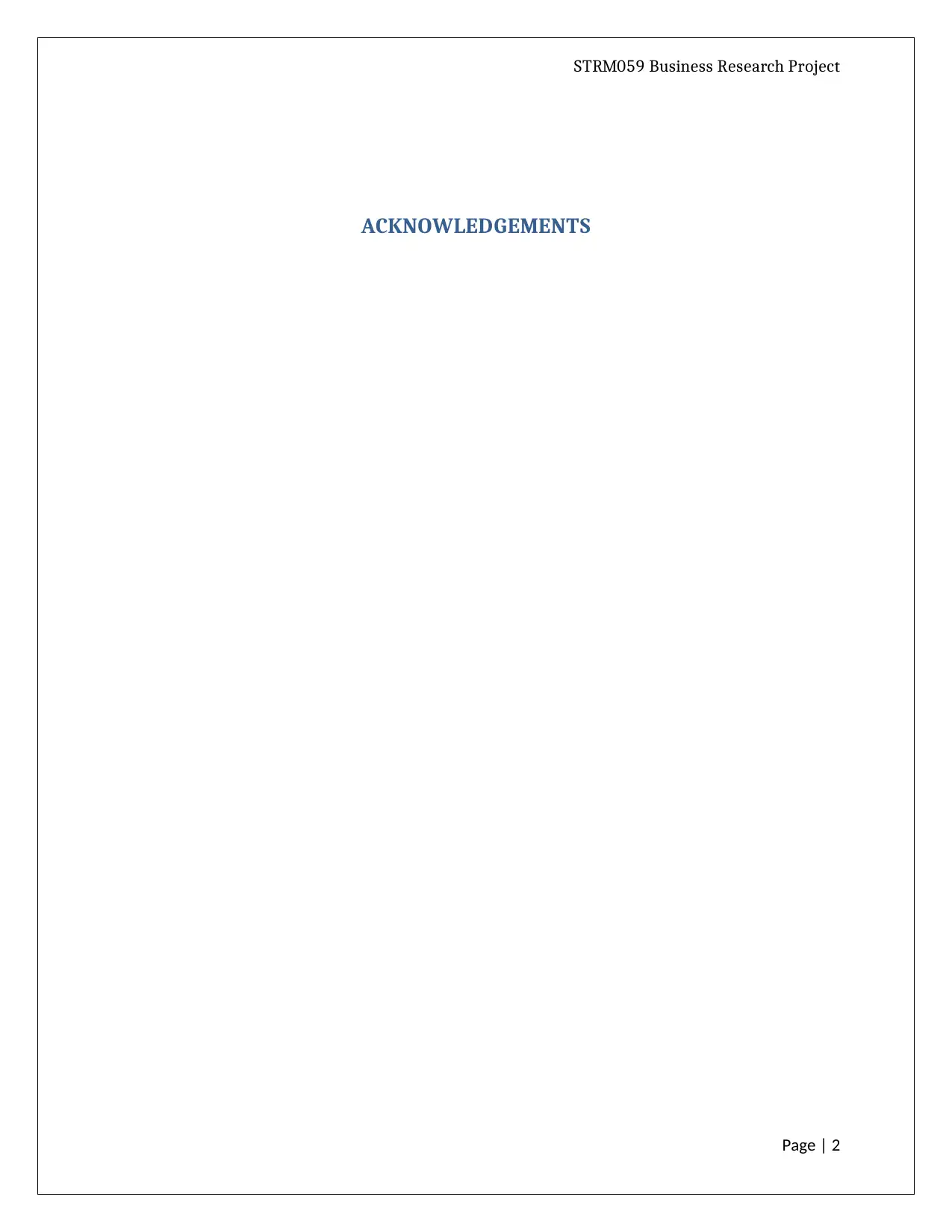
STRM059 Business Research Project
ACKNOWLEDGEMENTS
Page | 2
ACKNOWLEDGEMENTS
Page | 2
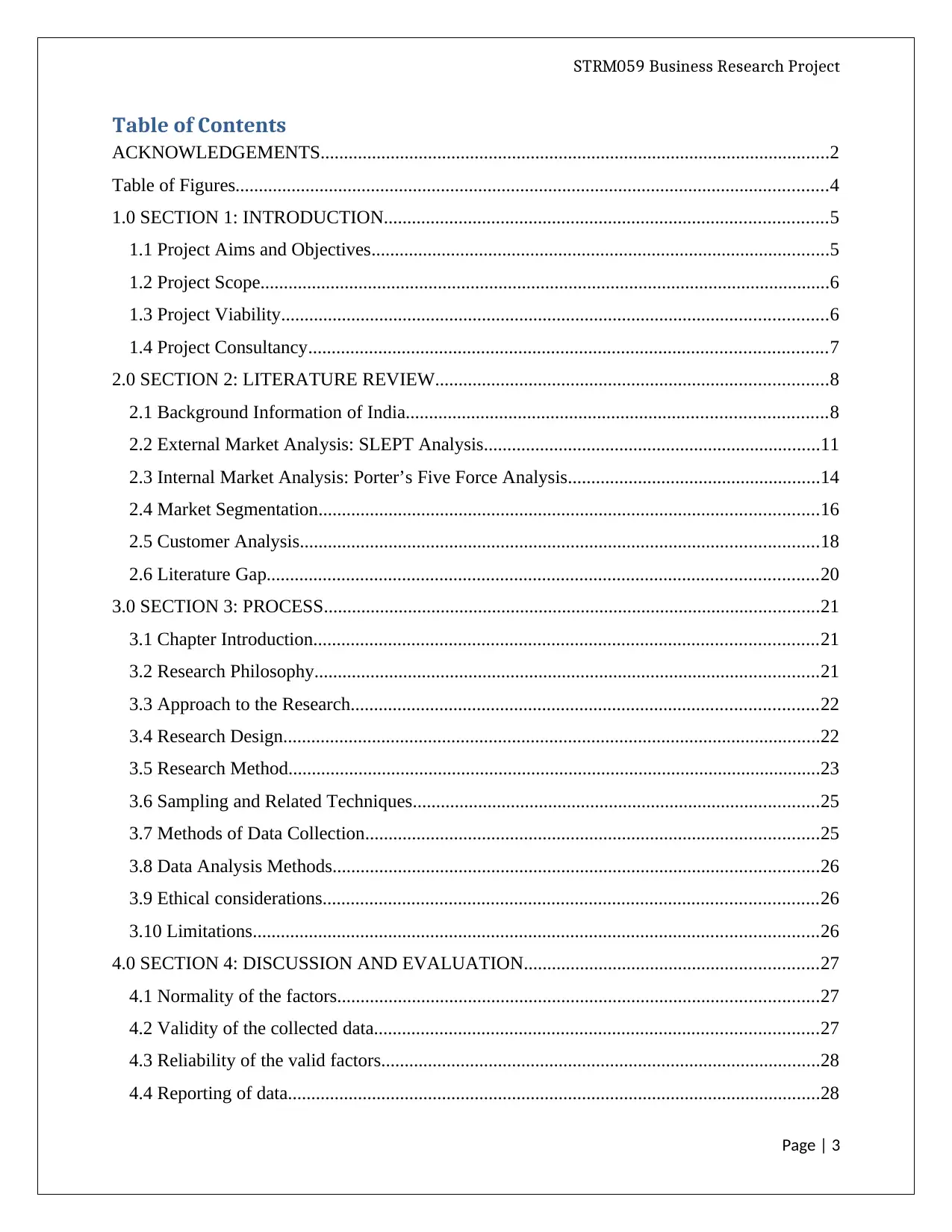
STRM059 Business Research Project
Table of Contents
ACKNOWLEDGEMENTS.............................................................................................................2
Table of Figures...............................................................................................................................4
1.0 SECTION 1: INTRODUCTION...............................................................................................5
1.1 Project Aims and Objectives..................................................................................................5
1.2 Project Scope..........................................................................................................................6
1.3 Project Viability.....................................................................................................................6
1.4 Project Consultancy...............................................................................................................7
2.0 SECTION 2: LITERATURE REVIEW....................................................................................8
2.1 Background Information of India..........................................................................................8
2.2 External Market Analysis: SLEPT Analysis........................................................................11
2.3 Internal Market Analysis: Porter’s Five Force Analysis......................................................14
2.4 Market Segmentation...........................................................................................................16
2.5 Customer Analysis...............................................................................................................18
2.6 Literature Gap......................................................................................................................20
3.0 SECTION 3: PROCESS..........................................................................................................21
3.1 Chapter Introduction............................................................................................................21
3.2 Research Philosophy............................................................................................................21
3.3 Approach to the Research....................................................................................................22
3.4 Research Design...................................................................................................................22
3.5 Research Method..................................................................................................................23
3.6 Sampling and Related Techniques.......................................................................................25
3.7 Methods of Data Collection.................................................................................................25
3.8 Data Analysis Methods........................................................................................................26
3.9 Ethical considerations..........................................................................................................26
3.10 Limitations.........................................................................................................................26
4.0 SECTION 4: DISCUSSION AND EVALUATION...............................................................27
4.1 Normality of the factors.......................................................................................................27
4.2 Validity of the collected data...............................................................................................27
4.3 Reliability of the valid factors..............................................................................................28
4.4 Reporting of data..................................................................................................................28
Page | 3
Table of Contents
ACKNOWLEDGEMENTS.............................................................................................................2
Table of Figures...............................................................................................................................4
1.0 SECTION 1: INTRODUCTION...............................................................................................5
1.1 Project Aims and Objectives..................................................................................................5
1.2 Project Scope..........................................................................................................................6
1.3 Project Viability.....................................................................................................................6
1.4 Project Consultancy...............................................................................................................7
2.0 SECTION 2: LITERATURE REVIEW....................................................................................8
2.1 Background Information of India..........................................................................................8
2.2 External Market Analysis: SLEPT Analysis........................................................................11
2.3 Internal Market Analysis: Porter’s Five Force Analysis......................................................14
2.4 Market Segmentation...........................................................................................................16
2.5 Customer Analysis...............................................................................................................18
2.6 Literature Gap......................................................................................................................20
3.0 SECTION 3: PROCESS..........................................................................................................21
3.1 Chapter Introduction............................................................................................................21
3.2 Research Philosophy............................................................................................................21
3.3 Approach to the Research....................................................................................................22
3.4 Research Design...................................................................................................................22
3.5 Research Method..................................................................................................................23
3.6 Sampling and Related Techniques.......................................................................................25
3.7 Methods of Data Collection.................................................................................................25
3.8 Data Analysis Methods........................................................................................................26
3.9 Ethical considerations..........................................................................................................26
3.10 Limitations.........................................................................................................................26
4.0 SECTION 4: DISCUSSION AND EVALUATION...............................................................27
4.1 Normality of the factors.......................................................................................................27
4.2 Validity of the collected data...............................................................................................27
4.3 Reliability of the valid factors..............................................................................................28
4.4 Reporting of data..................................................................................................................28
Page | 3
⊘ This is a preview!⊘
Do you want full access?
Subscribe today to unlock all pages.

Trusted by 1+ million students worldwide
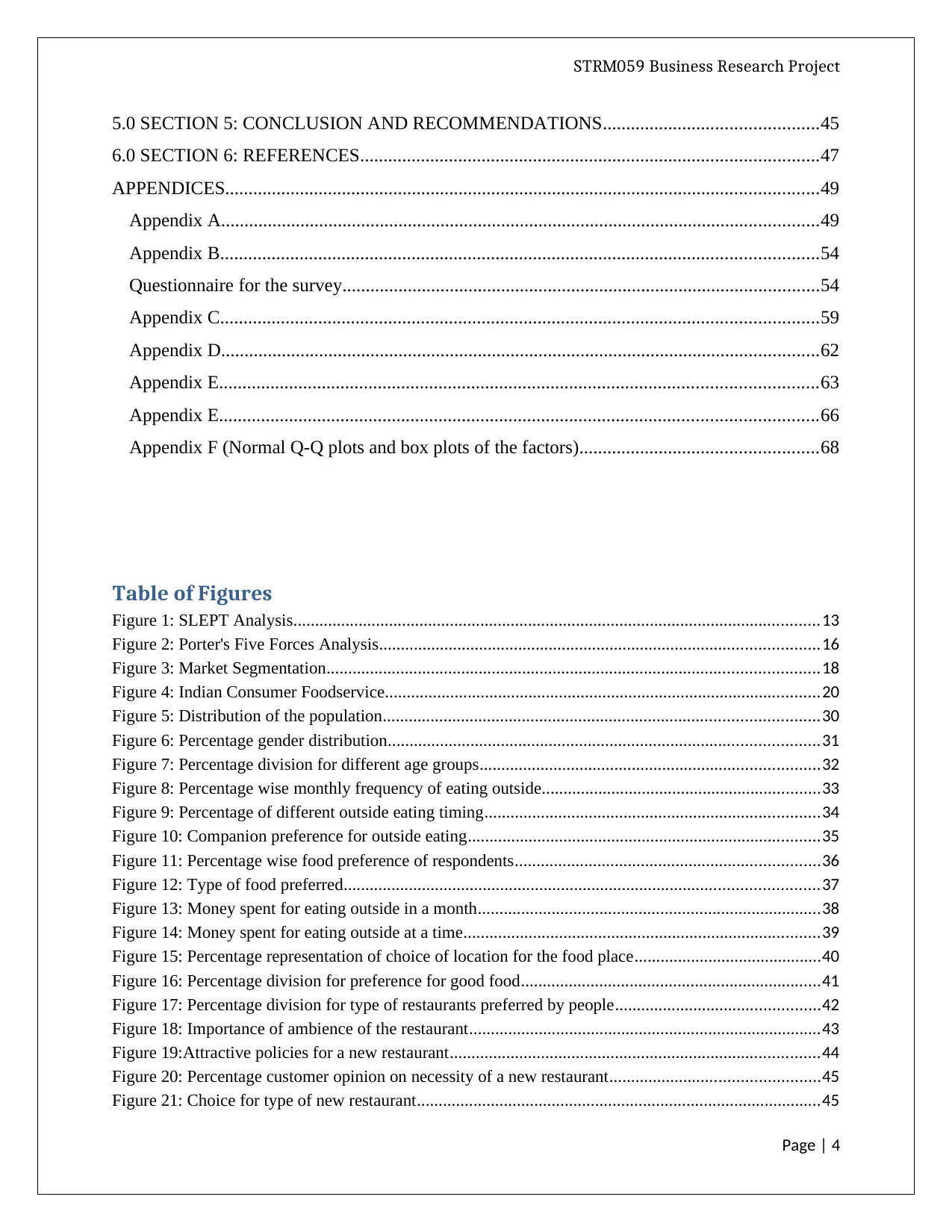
STRM059 Business Research Project
5.0 SECTION 5: CONCLUSION AND RECOMMENDATIONS..............................................45
6.0 SECTION 6: REFERENCES..................................................................................................47
APPENDICES...............................................................................................................................49
Appendix A................................................................................................................................49
Appendix B................................................................................................................................54
Questionnaire for the survey......................................................................................................54
Appendix C................................................................................................................................59
Appendix D................................................................................................................................62
Appendix E................................................................................................................................63
Appendix E................................................................................................................................66
Appendix F (Normal Q-Q plots and box plots of the factors)...................................................68
Table of Figures
Figure 1: SLEPT Analysis.........................................................................................................................13
Figure 2: Porter's Five Forces Analysis.....................................................................................................16
Figure 3: Market Segmentation.................................................................................................................18
Figure 4: Indian Consumer Foodservice....................................................................................................20
Figure 5: Distribution of the population....................................................................................................30
Figure 6: Percentage gender distribution...................................................................................................31
Figure 7: Percentage division for different age groups..............................................................................32
Figure 8: Percentage wise monthly frequency of eating outside................................................................33
Figure 9: Percentage of different outside eating timing.............................................................................34
Figure 10: Companion preference for outside eating.................................................................................35
Figure 11: Percentage wise food preference of respondents......................................................................36
Figure 12: Type of food preferred.............................................................................................................37
Figure 13: Money spent for eating outside in a month...............................................................................38
Figure 14: Money spent for eating outside at a time..................................................................................39
Figure 15: Percentage representation of choice of location for the food place...........................................40
Figure 16: Percentage division for preference for good food.....................................................................41
Figure 17: Percentage division for type of restaurants preferred by people...............................................42
Figure 18: Importance of ambience of the restaurant.................................................................................43
Figure 19:Attractive policies for a new restaurant.....................................................................................44
Figure 20: Percentage customer opinion on necessity of a new restaurant................................................45
Figure 21: Choice for type of new restaurant.............................................................................................45
Page | 4
5.0 SECTION 5: CONCLUSION AND RECOMMENDATIONS..............................................45
6.0 SECTION 6: REFERENCES..................................................................................................47
APPENDICES...............................................................................................................................49
Appendix A................................................................................................................................49
Appendix B................................................................................................................................54
Questionnaire for the survey......................................................................................................54
Appendix C................................................................................................................................59
Appendix D................................................................................................................................62
Appendix E................................................................................................................................63
Appendix E................................................................................................................................66
Appendix F (Normal Q-Q plots and box plots of the factors)...................................................68
Table of Figures
Figure 1: SLEPT Analysis.........................................................................................................................13
Figure 2: Porter's Five Forces Analysis.....................................................................................................16
Figure 3: Market Segmentation.................................................................................................................18
Figure 4: Indian Consumer Foodservice....................................................................................................20
Figure 5: Distribution of the population....................................................................................................30
Figure 6: Percentage gender distribution...................................................................................................31
Figure 7: Percentage division for different age groups..............................................................................32
Figure 8: Percentage wise monthly frequency of eating outside................................................................33
Figure 9: Percentage of different outside eating timing.............................................................................34
Figure 10: Companion preference for outside eating.................................................................................35
Figure 11: Percentage wise food preference of respondents......................................................................36
Figure 12: Type of food preferred.............................................................................................................37
Figure 13: Money spent for eating outside in a month...............................................................................38
Figure 14: Money spent for eating outside at a time..................................................................................39
Figure 15: Percentage representation of choice of location for the food place...........................................40
Figure 16: Percentage division for preference for good food.....................................................................41
Figure 17: Percentage division for type of restaurants preferred by people...............................................42
Figure 18: Importance of ambience of the restaurant.................................................................................43
Figure 19:Attractive policies for a new restaurant.....................................................................................44
Figure 20: Percentage customer opinion on necessity of a new restaurant................................................45
Figure 21: Choice for type of new restaurant.............................................................................................45
Page | 4
Paraphrase This Document
Need a fresh take? Get an instant paraphrase of this document with our AI Paraphraser
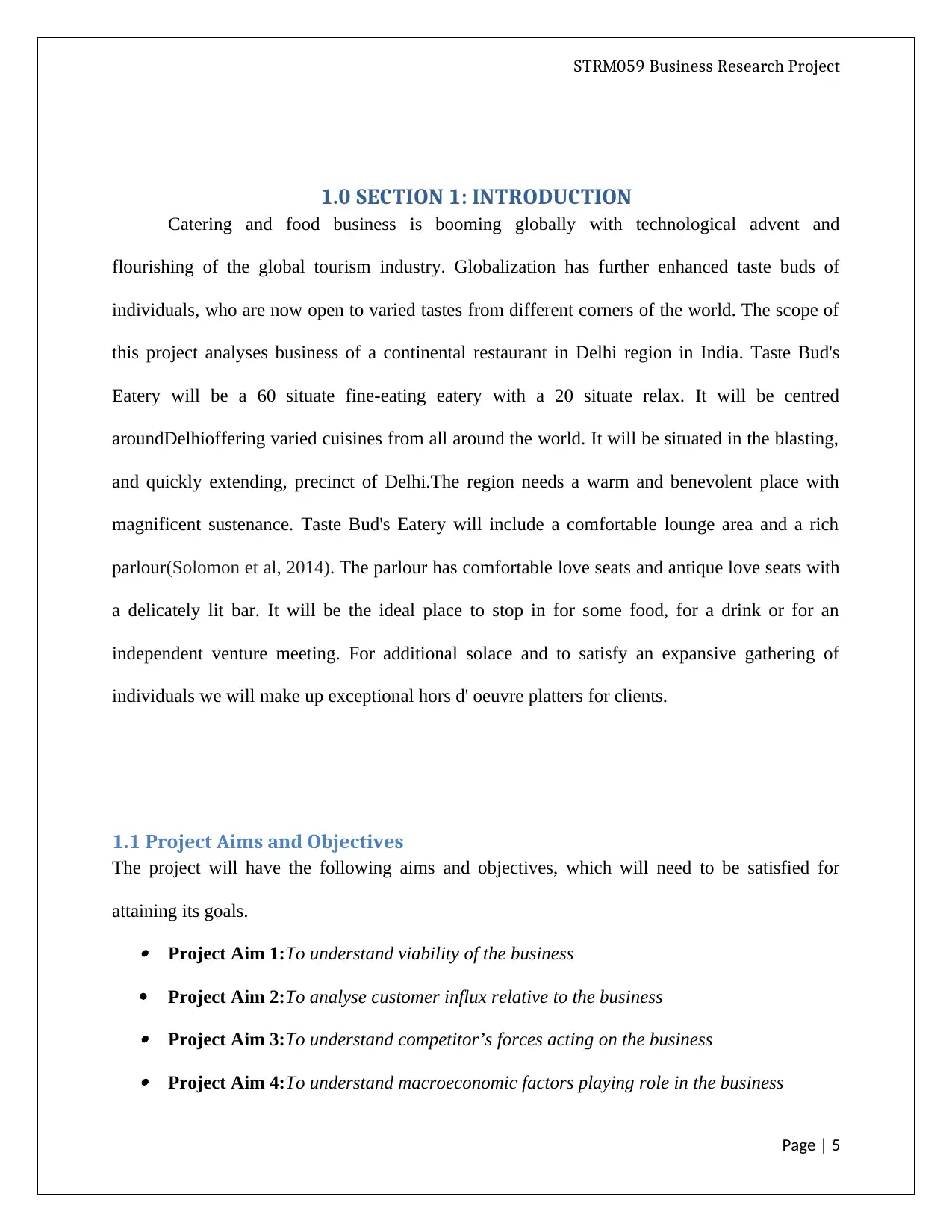
STRM059 Business Research Project
1.0 SECTION 1: INTRODUCTION
Catering and food business is booming globally with technological advent and
flourishing of the global tourism industry. Globalization has further enhanced taste buds of
individuals, who are now open to varied tastes from different corners of the world. The scope of
this project analyses business of a continental restaurant in Delhi region in India. Taste Bud's
Eatery will be a 60 situate fine-eating eatery with a 20 situate relax. It will be centred
aroundDelhioffering varied cuisines from all around the world. It will be situated in the blasting,
and quickly extending, precinct of Delhi.The region needs a warm and benevolent place with
magnificent sustenance. Taste Bud's Eatery will include a comfortable lounge area and a rich
parlour(Solomon et al, 2014). The parlour has comfortable love seats and antique love seats with
a delicately lit bar. It will be the ideal place to stop in for some food, for a drink or for an
independent venture meeting. For additional solace and to satisfy an expansive gathering of
individuals we will make up exceptional hors d' oeuvre platters for clients.
1.1 Project Aims and Objectives
The project will have the following aims and objectives, which will need to be satisfied for
attaining its goals. Project Aim 1:To understand viability of the business
Project Aim 2:To analyse customer influx relative to the business Project Aim 3:To understand competitor’s forces acting on the business Project Aim 4:To understand macroeconomic factors playing role in the business
Page | 5
1.0 SECTION 1: INTRODUCTION
Catering and food business is booming globally with technological advent and
flourishing of the global tourism industry. Globalization has further enhanced taste buds of
individuals, who are now open to varied tastes from different corners of the world. The scope of
this project analyses business of a continental restaurant in Delhi region in India. Taste Bud's
Eatery will be a 60 situate fine-eating eatery with a 20 situate relax. It will be centred
aroundDelhioffering varied cuisines from all around the world. It will be situated in the blasting,
and quickly extending, precinct of Delhi.The region needs a warm and benevolent place with
magnificent sustenance. Taste Bud's Eatery will include a comfortable lounge area and a rich
parlour(Solomon et al, 2014). The parlour has comfortable love seats and antique love seats with
a delicately lit bar. It will be the ideal place to stop in for some food, for a drink or for an
independent venture meeting. For additional solace and to satisfy an expansive gathering of
individuals we will make up exceptional hors d' oeuvre platters for clients.
1.1 Project Aims and Objectives
The project will have the following aims and objectives, which will need to be satisfied for
attaining its goals. Project Aim 1:To understand viability of the business
Project Aim 2:To analyse customer influx relative to the business Project Aim 3:To understand competitor’s forces acting on the business Project Aim 4:To understand macroeconomic factors playing role in the business
Page | 5
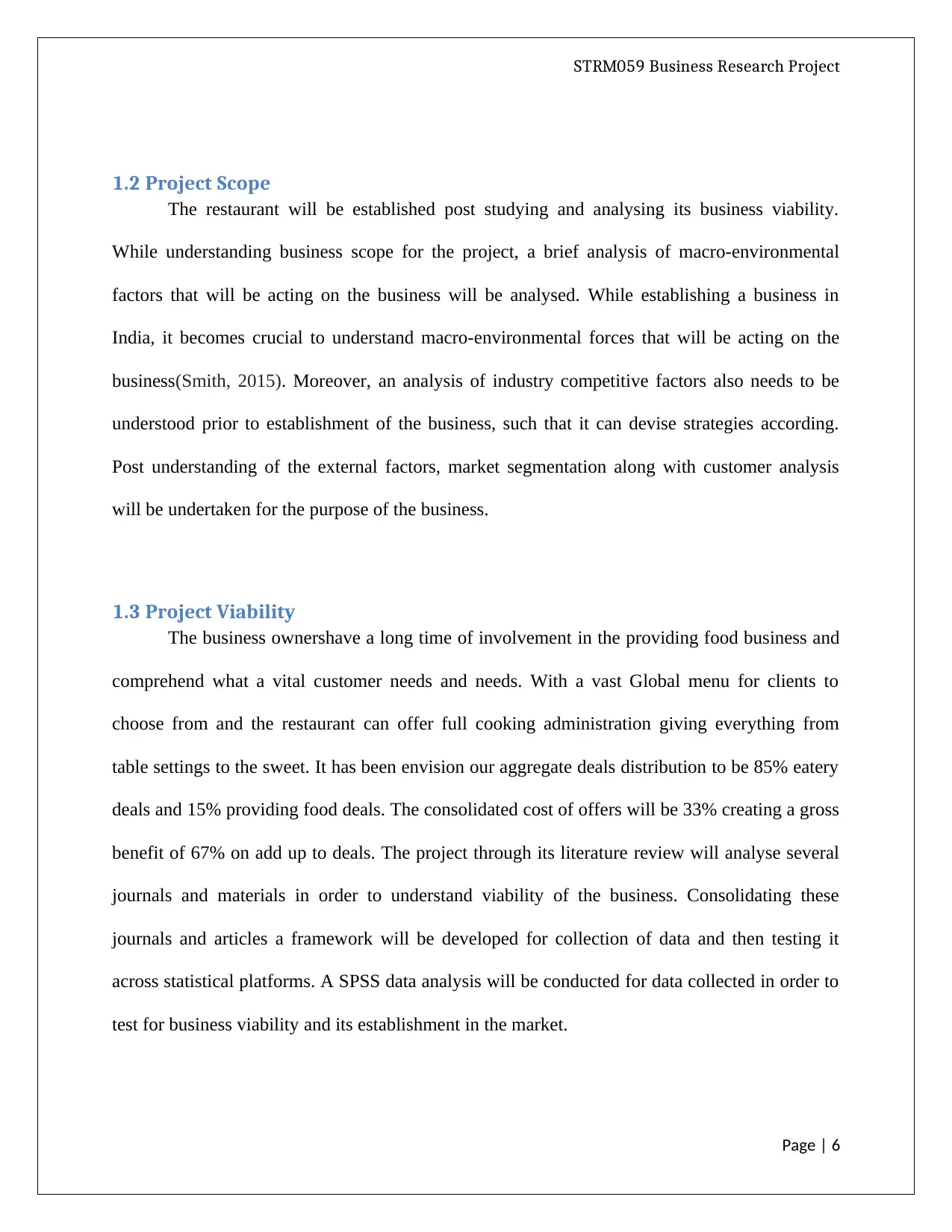
STRM059 Business Research Project
1.2 Project Scope
The restaurant will be established post studying and analysing its business viability.
While understanding business scope for the project, a brief analysis of macro-environmental
factors that will be acting on the business will be analysed. While establishing a business in
India, it becomes crucial to understand macro-environmental forces that will be acting on the
business(Smith, 2015). Moreover, an analysis of industry competitive factors also needs to be
understood prior to establishment of the business, such that it can devise strategies according.
Post understanding of the external factors, market segmentation along with customer analysis
will be undertaken for the purpose of the business.
1.3 Project Viability
The business ownershave a long time of involvement in the providing food business and
comprehend what a vital customer needs and needs. With a vast Global menu for clients to
choose from and the restaurant can offer full cooking administration giving everything from
table settings to the sweet. It has been envision our aggregate deals distribution to be 85% eatery
deals and 15% providing food deals. The consolidated cost of offers will be 33% creating a gross
benefit of 67% on add up to deals. The project through its literature review will analyse several
journals and materials in order to understand viability of the business. Consolidating these
journals and articles a framework will be developed for collection of data and then testing it
across statistical platforms. A SPSS data analysis will be conducted for data collected in order to
test for business viability and its establishment in the market.
Page | 6
1.2 Project Scope
The restaurant will be established post studying and analysing its business viability.
While understanding business scope for the project, a brief analysis of macro-environmental
factors that will be acting on the business will be analysed. While establishing a business in
India, it becomes crucial to understand macro-environmental forces that will be acting on the
business(Smith, 2015). Moreover, an analysis of industry competitive factors also needs to be
understood prior to establishment of the business, such that it can devise strategies according.
Post understanding of the external factors, market segmentation along with customer analysis
will be undertaken for the purpose of the business.
1.3 Project Viability
The business ownershave a long time of involvement in the providing food business and
comprehend what a vital customer needs and needs. With a vast Global menu for clients to
choose from and the restaurant can offer full cooking administration giving everything from
table settings to the sweet. It has been envision our aggregate deals distribution to be 85% eatery
deals and 15% providing food deals. The consolidated cost of offers will be 33% creating a gross
benefit of 67% on add up to deals. The project through its literature review will analyse several
journals and materials in order to understand viability of the business. Consolidating these
journals and articles a framework will be developed for collection of data and then testing it
across statistical platforms. A SPSS data analysis will be conducted for data collected in order to
test for business viability and its establishment in the market.
Page | 6
⊘ This is a preview!⊘
Do you want full access?
Subscribe today to unlock all pages.

Trusted by 1+ million students worldwide
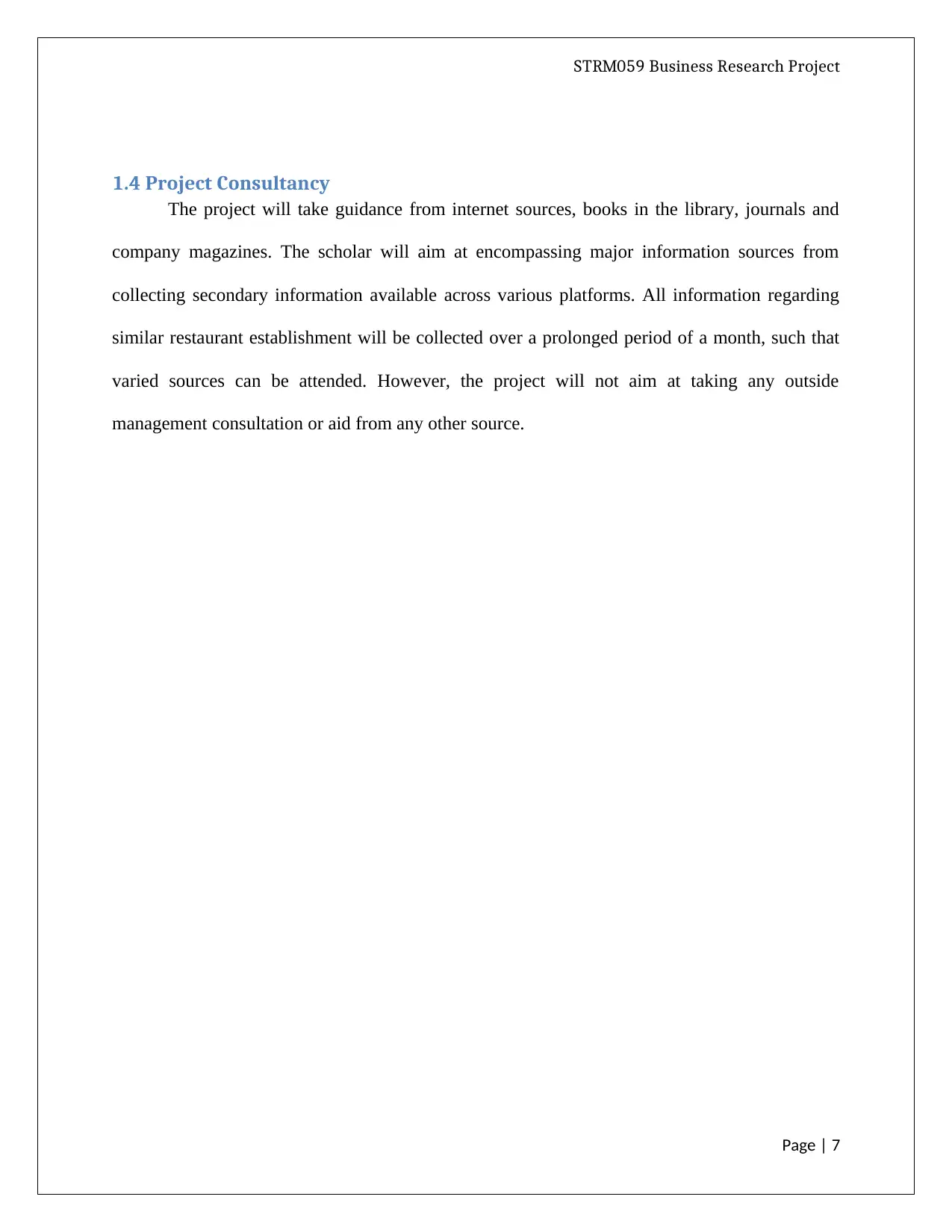
STRM059 Business Research Project
1.4 Project Consultancy
The project will take guidance from internet sources, books in the library, journals and
company magazines. The scholar will aim at encompassing major information sources from
collecting secondary information available across various platforms. All information regarding
similar restaurant establishment will be collected over a prolonged period of a month, such that
varied sources can be attended. However, the project will not aim at taking any outside
management consultation or aid from any other source.
Page | 7
1.4 Project Consultancy
The project will take guidance from internet sources, books in the library, journals and
company magazines. The scholar will aim at encompassing major information sources from
collecting secondary information available across various platforms. All information regarding
similar restaurant establishment will be collected over a prolonged period of a month, such that
varied sources can be attended. However, the project will not aim at taking any outside
management consultation or aid from any other source.
Page | 7
Paraphrase This Document
Need a fresh take? Get an instant paraphrase of this document with our AI Paraphraser
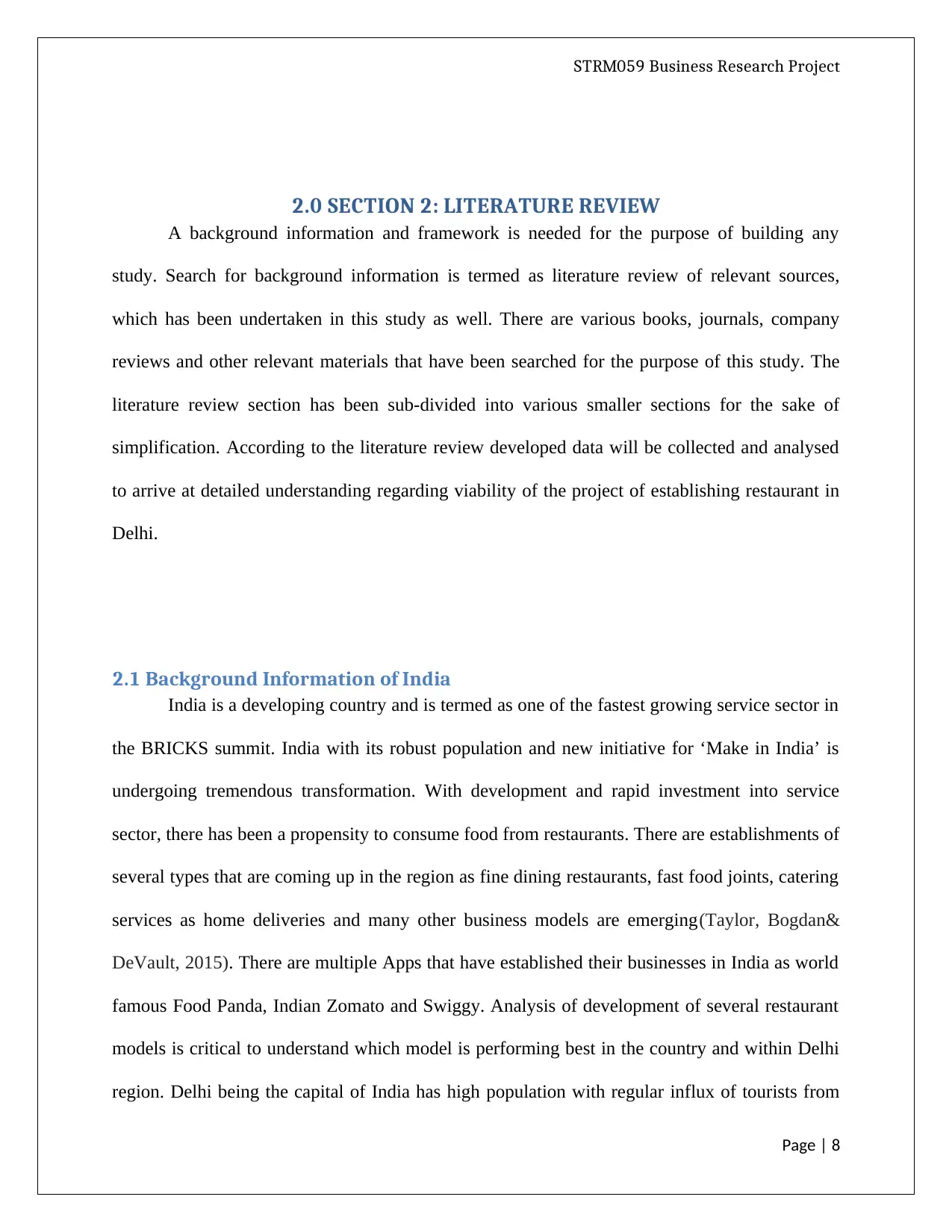
STRM059 Business Research Project
2.0 SECTION 2: LITERATURE REVIEW
A background information and framework is needed for the purpose of building any
study. Search for background information is termed as literature review of relevant sources,
which has been undertaken in this study as well. There are various books, journals, company
reviews and other relevant materials that have been searched for the purpose of this study. The
literature review section has been sub-divided into various smaller sections for the sake of
simplification. According to the literature review developed data will be collected and analysed
to arrive at detailed understanding regarding viability of the project of establishing restaurant in
Delhi.
2.1 Background Information of India
India is a developing country and is termed as one of the fastest growing service sector in
the BRICKS summit. India with its robust population and new initiative for ‘Make in India’ is
undergoing tremendous transformation. With development and rapid investment into service
sector, there has been a propensity to consume food from restaurants. There are establishments of
several types that are coming up in the region as fine dining restaurants, fast food joints, catering
services as home deliveries and many other business models are emerging(Taylor, Bogdan&
DeVault, 2015). There are multiple Apps that have established their businesses in India as world
famous Food Panda, Indian Zomato and Swiggy. Analysis of development of several restaurant
models is critical to understand which model is performing best in the country and within Delhi
region. Delhi being the capital of India has high population with regular influx of tourists from
Page | 8
2.0 SECTION 2: LITERATURE REVIEW
A background information and framework is needed for the purpose of building any
study. Search for background information is termed as literature review of relevant sources,
which has been undertaken in this study as well. There are various books, journals, company
reviews and other relevant materials that have been searched for the purpose of this study. The
literature review section has been sub-divided into various smaller sections for the sake of
simplification. According to the literature review developed data will be collected and analysed
to arrive at detailed understanding regarding viability of the project of establishing restaurant in
Delhi.
2.1 Background Information of India
India is a developing country and is termed as one of the fastest growing service sector in
the BRICKS summit. India with its robust population and new initiative for ‘Make in India’ is
undergoing tremendous transformation. With development and rapid investment into service
sector, there has been a propensity to consume food from restaurants. There are establishments of
several types that are coming up in the region as fine dining restaurants, fast food joints, catering
services as home deliveries and many other business models are emerging(Taylor, Bogdan&
DeVault, 2015). There are multiple Apps that have established their businesses in India as world
famous Food Panda, Indian Zomato and Swiggy. Analysis of development of several restaurant
models is critical to understand which model is performing best in the country and within Delhi
region. Delhi being the capital of India has high population with regular influx of tourists from
Page | 8
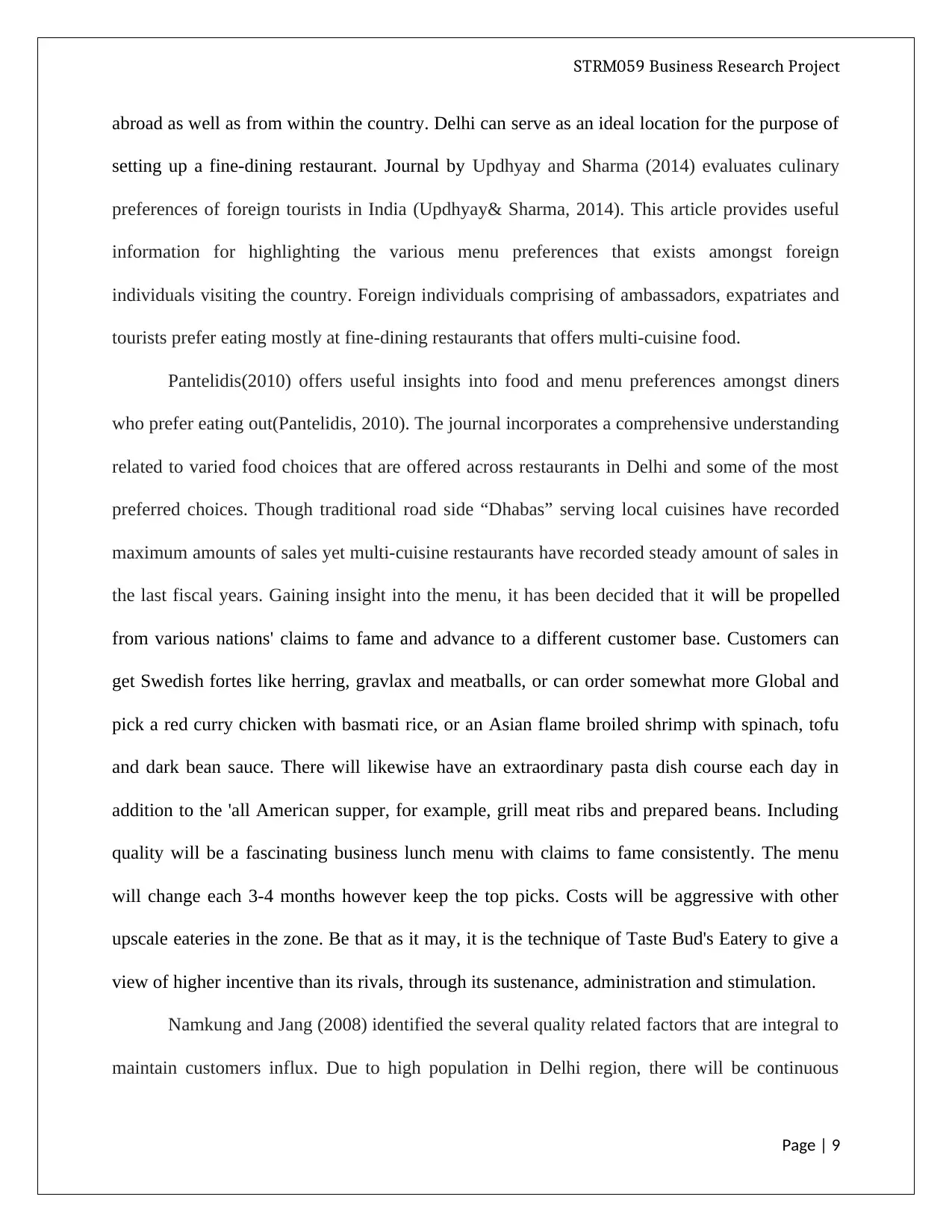
STRM059 Business Research Project
abroad as well as from within the country. Delhi can serve as an ideal location for the purpose of
setting up a fine-dining restaurant. Journal by Updhyay and Sharma (2014) evaluates culinary
preferences of foreign tourists in India (Updhyay& Sharma, 2014). This article provides useful
information for highlighting the various menu preferences that exists amongst foreign
individuals visiting the country. Foreign individuals comprising of ambassadors, expatriates and
tourists prefer eating mostly at fine-dining restaurants that offers multi-cuisine food.
Pantelidis(2010) offers useful insights into food and menu preferences amongst diners
who prefer eating out(Pantelidis, 2010). The journal incorporates a comprehensive understanding
related to varied food choices that are offered across restaurants in Delhi and some of the most
preferred choices. Though traditional road side “Dhabas” serving local cuisines have recorded
maximum amounts of sales yet multi-cuisine restaurants have recorded steady amount of sales in
the last fiscal years. Gaining insight into the menu, it has been decided that it will be propelled
from various nations' claims to fame and advance to a different customer base. Customers can
get Swedish fortes like herring, gravlax and meatballs, or can order somewhat more Global and
pick a red curry chicken with basmati rice, or an Asian flame broiled shrimp with spinach, tofu
and dark bean sauce. There will likewise have an extraordinary pasta dish course each day in
addition to the 'all American supper, for example, grill meat ribs and prepared beans. Including
quality will be a fascinating business lunch menu with claims to fame consistently. The menu
will change each 3-4 months however keep the top picks. Costs will be aggressive with other
upscale eateries in the zone. Be that as it may, it is the technique of Taste Bud's Eatery to give a
view of higher incentive than its rivals, through its sustenance, administration and stimulation.
Namkung and Jang (2008) identified the several quality related factors that are integral to
maintain customers influx. Due to high population in Delhi region, there will be continuous
Page | 9
abroad as well as from within the country. Delhi can serve as an ideal location for the purpose of
setting up a fine-dining restaurant. Journal by Updhyay and Sharma (2014) evaluates culinary
preferences of foreign tourists in India (Updhyay& Sharma, 2014). This article provides useful
information for highlighting the various menu preferences that exists amongst foreign
individuals visiting the country. Foreign individuals comprising of ambassadors, expatriates and
tourists prefer eating mostly at fine-dining restaurants that offers multi-cuisine food.
Pantelidis(2010) offers useful insights into food and menu preferences amongst diners
who prefer eating out(Pantelidis, 2010). The journal incorporates a comprehensive understanding
related to varied food choices that are offered across restaurants in Delhi and some of the most
preferred choices. Though traditional road side “Dhabas” serving local cuisines have recorded
maximum amounts of sales yet multi-cuisine restaurants have recorded steady amount of sales in
the last fiscal years. Gaining insight into the menu, it has been decided that it will be propelled
from various nations' claims to fame and advance to a different customer base. Customers can
get Swedish fortes like herring, gravlax and meatballs, or can order somewhat more Global and
pick a red curry chicken with basmati rice, or an Asian flame broiled shrimp with spinach, tofu
and dark bean sauce. There will likewise have an extraordinary pasta dish course each day in
addition to the 'all American supper, for example, grill meat ribs and prepared beans. Including
quality will be a fascinating business lunch menu with claims to fame consistently. The menu
will change each 3-4 months however keep the top picks. Costs will be aggressive with other
upscale eateries in the zone. Be that as it may, it is the technique of Taste Bud's Eatery to give a
view of higher incentive than its rivals, through its sustenance, administration and stimulation.
Namkung and Jang (2008) identified the several quality related factors that are integral to
maintain customers influx. Due to high population in Delhi region, there will be continuous
Page | 9
⊘ This is a preview!⊘
Do you want full access?
Subscribe today to unlock all pages.

Trusted by 1+ million students worldwide
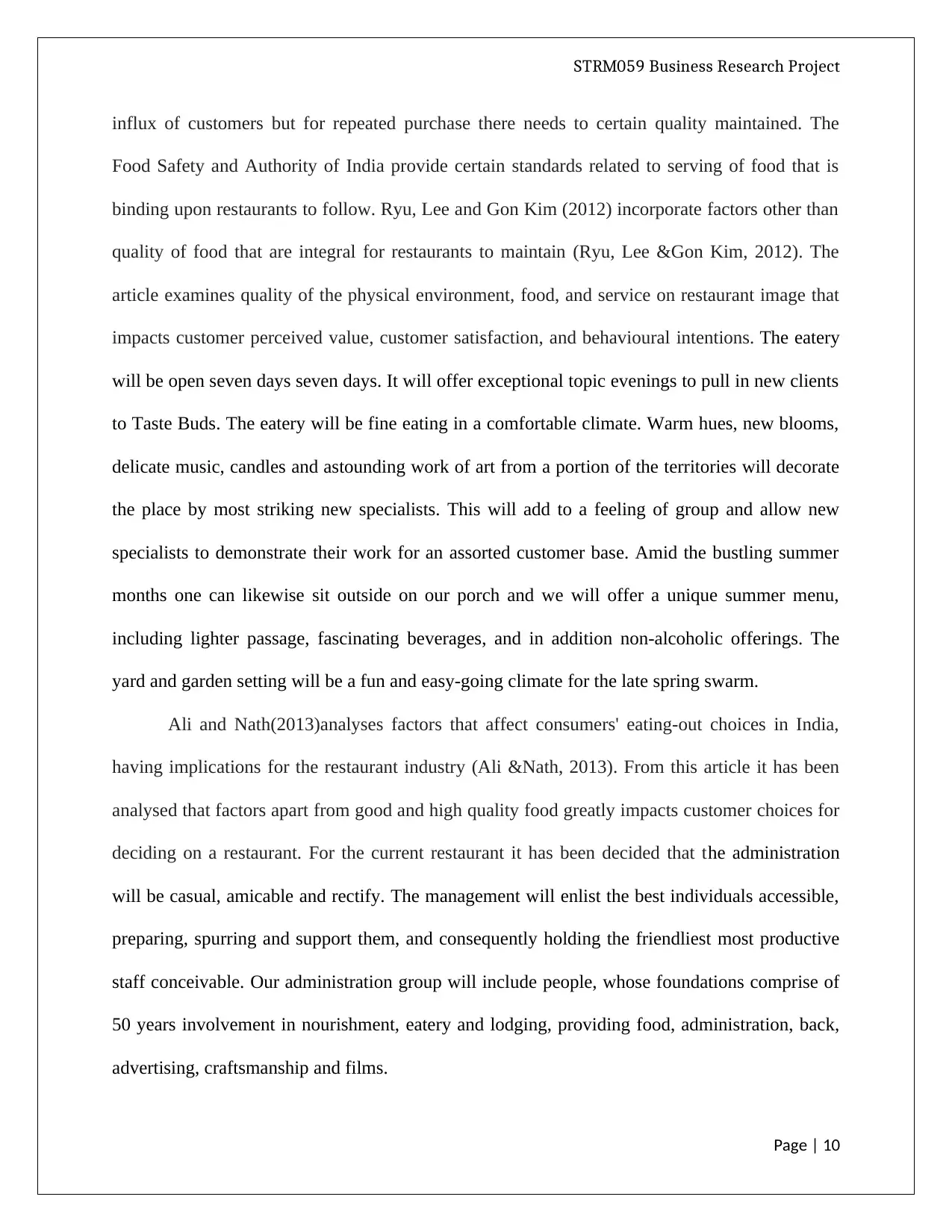
STRM059 Business Research Project
influx of customers but for repeated purchase there needs to certain quality maintained. The
Food Safety and Authority of India provide certain standards related to serving of food that is
binding upon restaurants to follow. Ryu, Lee and Gon Kim (2012) incorporate factors other than
quality of food that are integral for restaurants to maintain (Ryu, Lee &Gon Kim, 2012). The
article examines quality of the physical environment, food, and service on restaurant image that
impacts customer perceived value, customer satisfaction, and behavioural intentions. The eatery
will be open seven days seven days. It will offer exceptional topic evenings to pull in new clients
to Taste Buds. The eatery will be fine eating in a comfortable climate. Warm hues, new blooms,
delicate music, candles and astounding work of art from a portion of the territories will decorate
the place by most striking new specialists. This will add to a feeling of group and allow new
specialists to demonstrate their work for an assorted customer base. Amid the bustling summer
months one can likewise sit outside on our porch and we will offer a unique summer menu,
including lighter passage, fascinating beverages, and in addition non-alcoholic offerings. The
yard and garden setting will be a fun and easy-going climate for the late spring swarm.
Ali and Nath(2013)analyses factors that affect consumers' eating-out choices in India,
having implications for the restaurant industry (Ali &Nath, 2013). From this article it has been
analysed that factors apart from good and high quality food greatly impacts customer choices for
deciding on a restaurant. For the current restaurant it has been decided that the administration
will be casual, amicable and rectify. The management will enlist the best individuals accessible,
preparing, spurring and support them, and consequently holding the friendliest most productive
staff conceivable. Our administration group will include people, whose foundations comprise of
50 years involvement in nourishment, eatery and lodging, providing food, administration, back,
advertising, craftsmanship and films.
Page | 10
influx of customers but for repeated purchase there needs to certain quality maintained. The
Food Safety and Authority of India provide certain standards related to serving of food that is
binding upon restaurants to follow. Ryu, Lee and Gon Kim (2012) incorporate factors other than
quality of food that are integral for restaurants to maintain (Ryu, Lee &Gon Kim, 2012). The
article examines quality of the physical environment, food, and service on restaurant image that
impacts customer perceived value, customer satisfaction, and behavioural intentions. The eatery
will be open seven days seven days. It will offer exceptional topic evenings to pull in new clients
to Taste Buds. The eatery will be fine eating in a comfortable climate. Warm hues, new blooms,
delicate music, candles and astounding work of art from a portion of the territories will decorate
the place by most striking new specialists. This will add to a feeling of group and allow new
specialists to demonstrate their work for an assorted customer base. Amid the bustling summer
months one can likewise sit outside on our porch and we will offer a unique summer menu,
including lighter passage, fascinating beverages, and in addition non-alcoholic offerings. The
yard and garden setting will be a fun and easy-going climate for the late spring swarm.
Ali and Nath(2013)analyses factors that affect consumers' eating-out choices in India,
having implications for the restaurant industry (Ali &Nath, 2013). From this article it has been
analysed that factors apart from good and high quality food greatly impacts customer choices for
deciding on a restaurant. For the current restaurant it has been decided that the administration
will be casual, amicable and rectify. The management will enlist the best individuals accessible,
preparing, spurring and support them, and consequently holding the friendliest most productive
staff conceivable. Our administration group will include people, whose foundations comprise of
50 years involvement in nourishment, eatery and lodging, providing food, administration, back,
advertising, craftsmanship and films.
Page | 10
Paraphrase This Document
Need a fresh take? Get an instant paraphrase of this document with our AI Paraphraser
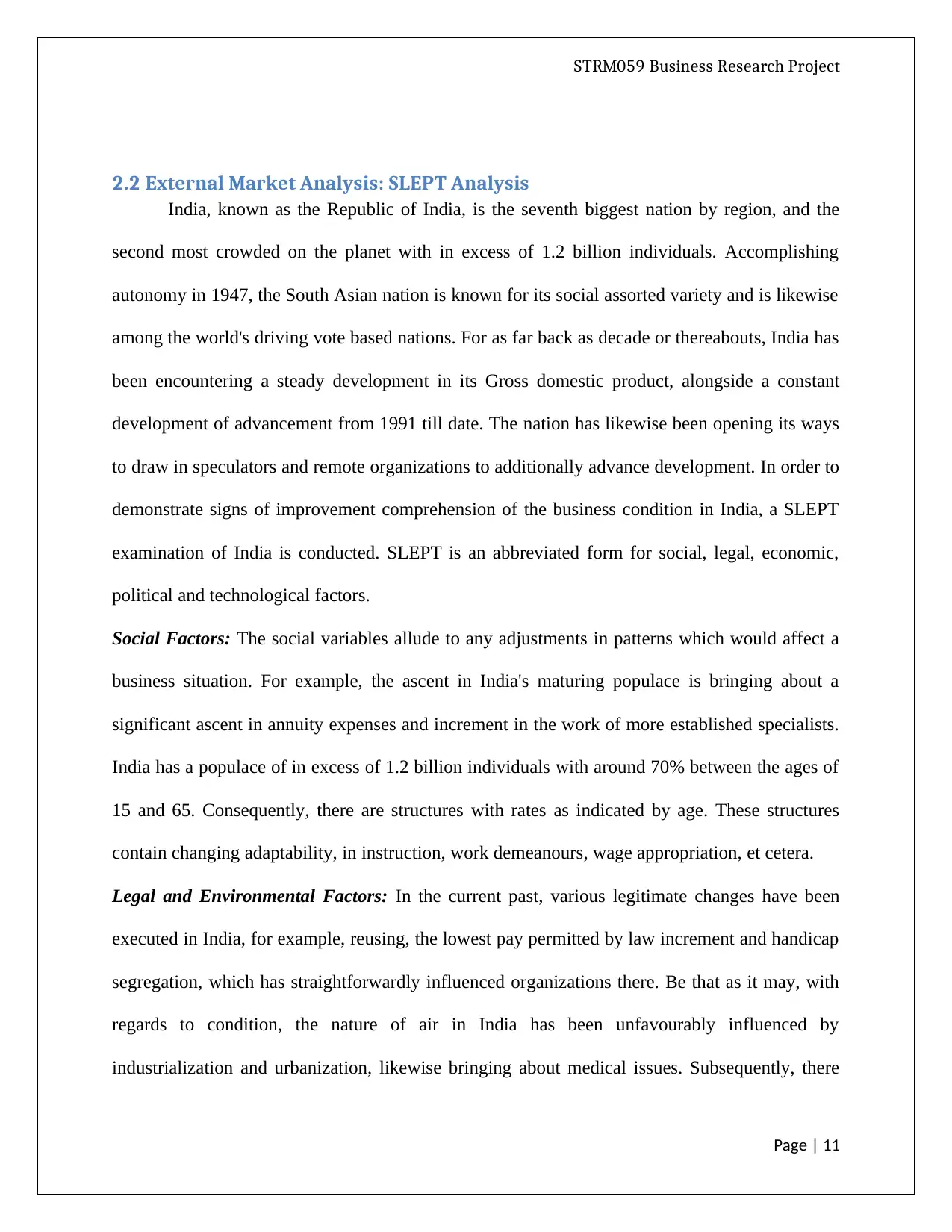
STRM059 Business Research Project
2.2 External Market Analysis: SLEPT Analysis
India, known as the Republic of India, is the seventh biggest nation by region, and the
second most crowded on the planet with in excess of 1.2 billion individuals. Accomplishing
autonomy in 1947, the South Asian nation is known for its social assorted variety and is likewise
among the world's driving vote based nations. For as far back as decade or thereabouts, India has
been encountering a steady development in its Gross domestic product, alongside a constant
development of advancement from 1991 till date. The nation has likewise been opening its ways
to draw in speculators and remote organizations to additionally advance development. In order to
demonstrate signs of improvement comprehension of the business condition in India, a SLEPT
examination of India is conducted. SLEPT is an abbreviated form for social, legal, economic,
political and technological factors.
Social Factors: The social variables allude to any adjustments in patterns which would affect a
business situation. For example, the ascent in India's maturing populace is bringing about a
significant ascent in annuity expenses and increment in the work of more established specialists.
India has a populace of in excess of 1.2 billion individuals with around 70% between the ages of
15 and 65. Consequently, there are structures with rates as indicated by age. These structures
contain changing adaptability, in instruction, work demeanours, wage appropriation, et cetera.
Legal and Environmental Factors: In the current past, various legitimate changes have been
executed in India, for example, reusing, the lowest pay permitted by law increment and handicap
segregation, which has straightforwardly influenced organizations there. Be that as it may, with
regards to condition, the nature of air in India has been unfavourably influenced by
industrialization and urbanization, likewise bringing about medical issues. Subsequently, there
Page | 11
2.2 External Market Analysis: SLEPT Analysis
India, known as the Republic of India, is the seventh biggest nation by region, and the
second most crowded on the planet with in excess of 1.2 billion individuals. Accomplishing
autonomy in 1947, the South Asian nation is known for its social assorted variety and is likewise
among the world's driving vote based nations. For as far back as decade or thereabouts, India has
been encountering a steady development in its Gross domestic product, alongside a constant
development of advancement from 1991 till date. The nation has likewise been opening its ways
to draw in speculators and remote organizations to additionally advance development. In order to
demonstrate signs of improvement comprehension of the business condition in India, a SLEPT
examination of India is conducted. SLEPT is an abbreviated form for social, legal, economic,
political and technological factors.
Social Factors: The social variables allude to any adjustments in patterns which would affect a
business situation. For example, the ascent in India's maturing populace is bringing about a
significant ascent in annuity expenses and increment in the work of more established specialists.
India has a populace of in excess of 1.2 billion individuals with around 70% between the ages of
15 and 65. Consequently, there are structures with rates as indicated by age. These structures
contain changing adaptability, in instruction, work demeanours, wage appropriation, et cetera.
Legal and Environmental Factors: In the current past, various legitimate changes have been
executed in India, for example, reusing, the lowest pay permitted by law increment and handicap
segregation, which has straightforwardly influenced organizations there. Be that as it may, with
regards to condition, the nature of air in India has been unfavourably influenced by
industrialization and urbanization, likewise bringing about medical issues. Subsequently, there
Page | 11
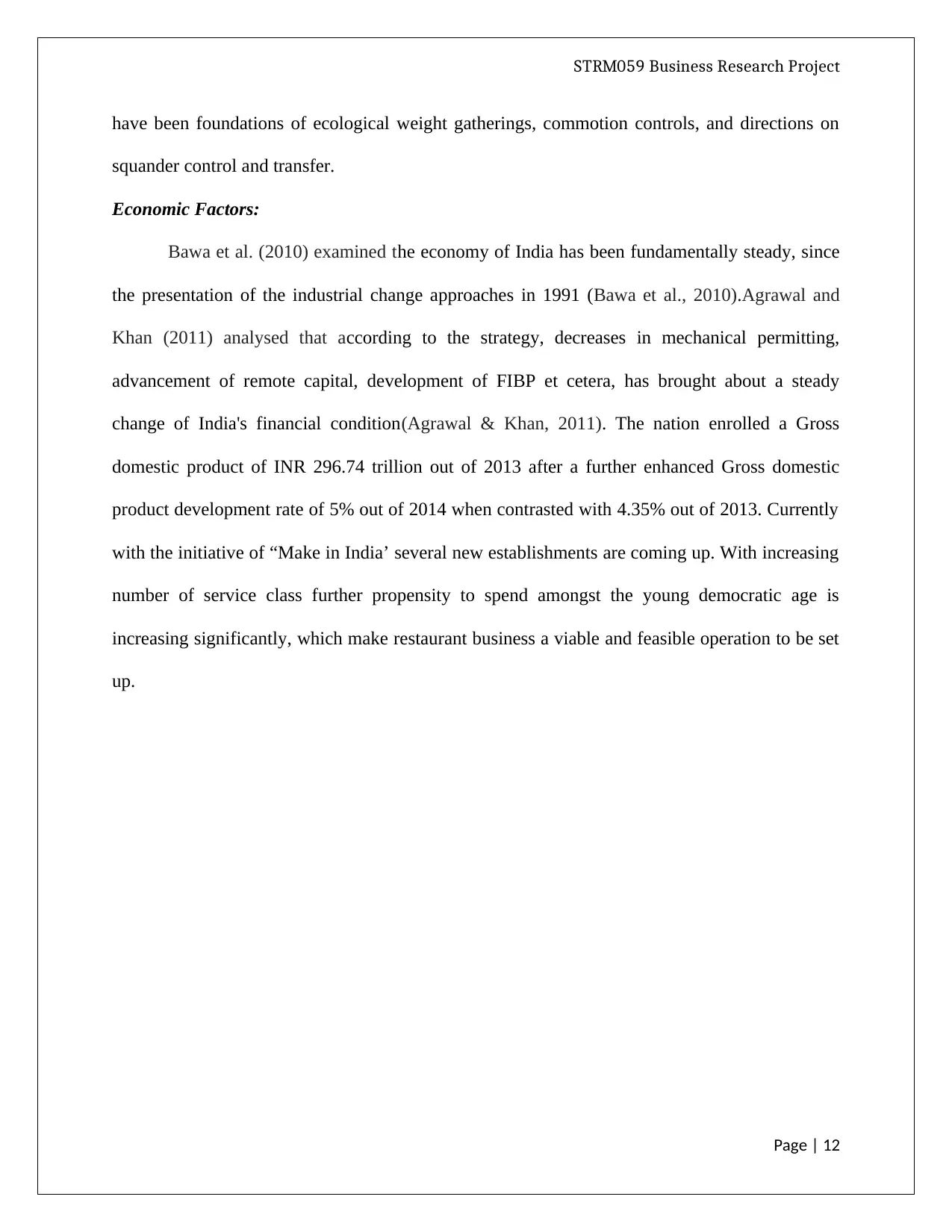
STRM059 Business Research Project
have been foundations of ecological weight gatherings, commotion controls, and directions on
squander control and transfer.
Economic Factors:
Bawa et al. (2010) examined the economy of India has been fundamentally steady, since
the presentation of the industrial change approaches in 1991 (Bawa et al., 2010).Agrawal and
Khan (2011) analysed that according to the strategy, decreases in mechanical permitting,
advancement of remote capital, development of FIBP et cetera, has brought about a steady
change of India's financial condition(Agrawal & Khan, 2011). The nation enrolled a Gross
domestic product of INR 296.74 trillion out of 2013 after a further enhanced Gross domestic
product development rate of 5% out of 2014 when contrasted with 4.35% out of 2013. Currently
with the initiative of “Make in India’ several new establishments are coming up. With increasing
number of service class further propensity to spend amongst the young democratic age is
increasing significantly, which make restaurant business a viable and feasible operation to be set
up.
Page | 12
have been foundations of ecological weight gatherings, commotion controls, and directions on
squander control and transfer.
Economic Factors:
Bawa et al. (2010) examined the economy of India has been fundamentally steady, since
the presentation of the industrial change approaches in 1991 (Bawa et al., 2010).Agrawal and
Khan (2011) analysed that according to the strategy, decreases in mechanical permitting,
advancement of remote capital, development of FIBP et cetera, has brought about a steady
change of India's financial condition(Agrawal & Khan, 2011). The nation enrolled a Gross
domestic product of INR 296.74 trillion out of 2013 after a further enhanced Gross domestic
product development rate of 5% out of 2014 when contrasted with 4.35% out of 2013. Currently
with the initiative of “Make in India’ several new establishments are coming up. With increasing
number of service class further propensity to spend amongst the young democratic age is
increasing significantly, which make restaurant business a viable and feasible operation to be set
up.
Page | 12
⊘ This is a preview!⊘
Do you want full access?
Subscribe today to unlock all pages.

Trusted by 1+ million students worldwide
1 out of 84
Related Documents
Your All-in-One AI-Powered Toolkit for Academic Success.
+13062052269
info@desklib.com
Available 24*7 on WhatsApp / Email
![[object Object]](/_next/static/media/star-bottom.7253800d.svg)
Unlock your academic potential
Copyright © 2020–2025 A2Z Services. All Rights Reserved. Developed and managed by ZUCOL.



